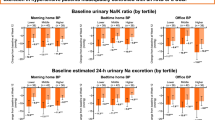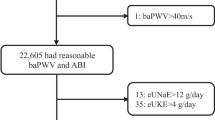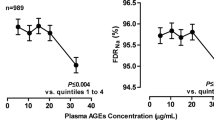Abstract
In a population with high sodium consumption, we assessed relation between brachial and central blood pressures, elastic properties of large arteries, echocardiographic left ventricular diastolic function and sodium reabsorption as fractional urinary lithium excretion in proximal (FELi) and fractional sodium reabsorption in distal tubules assessed using the endogenous lithium clearance. Mean±s.d. age of 131 treated hypertensive patients (66 men and 65 women) was 61.9±7.5 years. We found significant interaction between left ventricular diastolic function and FELi with respect to the values of brachial blood pressure: systolic (SBP), diastolic (DBP) and mean blood pressure (MBP) (all PINT<0.03). In patients with FELi below the median value and impaired left ventricular diastolic function, the values of SBP (149.3 vs 132.5 mm Hg; P=0.005), DBP (85.1 vs 76.1 mm Hg; P=0.001), MBP (106.5 vs 94.9 mm Hg; P=0.001), central SBP (SBPC) (137.4 vs 122.0 mm Hg; P=0.01), central DBP (DBPC) (84.8 vs 76.0 mm Hg; P=0.003), central MBP (MBPC) (106.9 vs 95.9 mm Hg; P=0.007), aortic pulse wave augmentation (18.0 vs 13.5 mm Hg; P=0.03), pulse wave velocity (14.6 vs 12.5 m s−1; P=0.02) and central aortic pulse wave augmentation index (155.7% vs 140.9%; P=0.01) were significantly higher than in patients with normal left ventricular diastolic function. Such relationships were not observed in the entire group and patients with FELi above the median value. In the hypertensive population with high sodium intake, increased sodium reabsorption in proximal tubules may affect blood pressure parameters and arterial wall damage, thus contributing to the development of left ventricular diastolic function impairment.
This is a preview of subscription content, access via your institution
Access options
Subscribe to this journal
Receive 12 digital issues and online access to articles
$119.00 per year
only $9.92 per issue
Buy this article
- Purchase on Springer Link
- Instant access to full article PDF
Prices may be subject to local taxes which are calculated during checkout


Similar content being viewed by others
References
Et-Taoui K, Schiavi P, Levy B, Plante G . Sodium intake, large artery stiffness, and proteoglycans in the spontaneously hypertensive rat. Hypertension 2001; 38: 1172–1176.
Levy BI, Poitevin P, Safar ME . Effect of indapamide on the mechanical properties of the arterial wall in deoxycorticosterone acetate-salt hypertensive rats. Am J Cardiol 1990; 65: 28–32.
Avolio AP, Deng FQ, Li WQ, Huang ZD, Xing LF, O'Rourke MF . Effects of aging on arterial distensibility in populations with high and low prevalence of hypertension: comparison between urban and rural communities in China. Circulation 1985; 71: 202–210.
Redelinghuys M, Norton GR, Scott L, Maseko MJ, Brooksbank R, Majane OH et al. Relationship between urinary salt excretion and pulse pressure and central aortic hemodynamics independent of steady state pressure in the general population. Hypertension 2010; 56: 584–590.
Burnier M, Phan O, Wang Q . High salt intake: a cause of blood pressure-independent left ventricular hypertrophy? Nephrol Dial Transplant 2007; 22: 2426–2429.
Langenfeld MR, Schobel H, Veelken R, Weihprecht H, Schmieder RE . Impact of dietary sodium intake on left ventricular diastolic filling in early essential hypertension. Eur Heart J 1998; 19: 951–958.
Burnier M, Biollaz J, Magnin JL, Bidlingmeyer M, Brunner HR . Renal sodium handling in patients with untreated hypertension and white coat hypertension. Hypertension 1994; 3: 496–502.
Strazzullo P, Galletti F, Barba G . Altered renal handling of sodium in human hypertension: short review of the evidence. Hypertension 2003; 41: 1000–1005.
Weder AB . Red-cell lithium-sodium countertransport and renal lithium clearance in hypertension. N Engl J Med 1986; 314: 198–201.
Chiolero A, Maillard M, Nussberger J, Brunner HR, Burnier M . Proximal sodium reabsorption: an independent determinant of blood pressure response to salt. Hypertension 2000; 36: 631–637.
Zou J, Li Y, Yan CH, Wei FF, Zhang L, Wang JG . Blood pressure in relation to interactions between sodium dietary intake and renal handling. Hypertension 2013; 62: 719–725.
Cappuccio FP, Strazzullo P, Farinaro E, Trevisan M . Uric acid metabolism and tubular sodium handling. Results from a population-based study. JAMA 1993; 270: 354–359.
Cappuccio FP, Strazzullo P, Siani A, Trevisan M . Increased proximal sodium reabsorption is associated with increased cardiovascular risk in men. J Hypertens 1996; 14: 909–914.
Seidlerová J, Staessen JA, Maillard M, Nawrot T, Zhang H, Bochud M et al. Association between arterial properties and renal sodium handling in a general population. Hypertension 2006; 48: 609–615.
Jin Y, Kuznetsova T, Maillard M, Richart T, Thijs L, Bochud M et al. Independent relations of left ventricular structure with the 24-hour urinary excretion of sodium and aldosterone. Hypertension 2009; 54: 489–495.
Cwynar M, Staessen JA, Ticha M, Nawrot T, Citterio L, Kuznetsova T et al. Epistatic interaction between α- and γ-adducin influences peripheral and central pulse pressures in white Europeans. J Hypertens 2005; 23: 961–969.
Christensen S . Furosemide effect during volume expansion: evidence against lithium transport in the loop. Kidney Int Suppl 1990; 28: S45–S51.
Paulus WJ, Tschöpe C, Sanderson JE, Rusconi C, Flachskampf FA, Rademakers FE et al. How to diagnose diastolic heart failure: a consensus statement on the diagnosis of heart failure with normal left ventricular ejection fraction by the Heart Failure and Echocardiography Associations of the European Society of Cardiology. Eur Heart J 2007; 28: 2539–2550.
Zhao J, Gao P, Wu S, Zhu D . Determination of trace lithium in human urine by electrothermal atomic absorption spectrometry using nitric acid as a chemical modifier to eliminate the interference of chloride. Anal Sci 2009; 25: 639–643.
Miller NL, Durr JA, Alfrey AC . Measurement of endogenous lithium levels in serum and urine by electrothermal atomic absorption spectrometry: a method with potential clinical applications. Anal Biochem 1989; 182: 245–249.
Staessen JA, Kuznetsova T, Zhang H, Maillard M, Bochud M, Hasenkamp S et al. Blood pressure and renal sodium handling in relation to genetic variation in the DRD1 promoter and GRK4. Hypertension 2008; 51: 1643–1650.
Safar ME, Thuilliez C, Richard V, Benetos A . Pressure-independent contribution of sodium to large artery structure and function in hypertension. Cardiovasc Res 2000; 46: 269–276.
Partovian C, Benetos A, Pommies JP, Mischler W, Safar ME . Effects of a chronic high-salt diet on large artery structure: role of endogenous bradykinin. Am J Physiol 1998; 274: 1423–1428.
Gu JW, Anand V, Shek EW, Moore MC, Brady AL, Kelly WC et al. Sodium induces hypertrophy of cultured myocardial myoblasts and vascular smooth muscle cells. Hypertension 1998; 31: 1083–1087.
Hollenberg NK, Meggs LG, Williams GH, Katz J, Garnic JD, Harrington DP . Sodium intake and renal responses to captopril in normal man and in essential hypertension. Kidney Int 1981; 20: 240–245.
Burnier M, Rutschmann B, Nussberger J, Versaggi J, Shahinfar S, Waeber B et al. Salt-dependent renal effects of an angiotensin II antagonist in healthy subjects. Hypertension 1993; 22: 339–347.
Noormohamed FH, Fuller GN, Lant AF . Effect of salt balance on the renal and hemodynamic actions of benazepril in normal men. J Clin Pharmacol 1989; 29: 928–937.
Valvo E, Casagrande P, Bedogna V, Antiga L, Alberti D, Zamboni M et al. Systemic and renal effects of a new angiotensin converting enzyme inhibitor, benazepril, in essential hypertension. J Hypertens 1990; 8: 991–995.
Williams B, Lacy PS, Thom SM, Cruickshank K, Stanton A, Collier D et al. Differential impact of blood pressure-lowering drugs on central aortic pressure and clinical outcomes: principal results of the Conduit Artery Function Evaluation (CAFE) study. Circulation 2006; 113: 1213–1225.
Wiliams B, Lacy PS . CAFÉ and the ASCOT (Anglo-Scandinavian Cardiac Outcomes Trial) Investigators. Impact of the heart rate on central arterial pressures and hemodynamics: analysis from the CAFE (Conduit Artery Function Evaluation) study: CAFE-Heart Rate. J Am Coll Cardiol 2009; 54: 705–713.
Acknowledgements
This study was supported by a Grant provided by the National Science Center, Poland (Grant No. N N402 533239).
Author information
Authors and Affiliations
Corresponding author
Ethics declarations
Competing interests
The authors declare no conflict of interest.
Additional information
Supplementary Information accompanies this paper on the Journal of Human Hypertension website
Rights and permissions
About this article
Cite this article
Cwynar, M., Gąsowski, J., Stompór, T. et al. Blood pressure and arterial stiffness in patients with high sodium intake in relation to sodium handling and left ventricular diastolic dysfunction status. J Hum Hypertens 29, 583–591 (2015). https://doi.org/10.1038/jhh.2015.1
Received:
Revised:
Accepted:
Published:
Issue Date:
DOI: https://doi.org/10.1038/jhh.2015.1
This article is cited by
-
Relationships between urinary electrolytes excretion and central hemodynamics, and arterial stiffness in hypertensive patients
Hypertension Research (2017)
-
Salt, hypertension, vascular stiffness and diastolic dysfunction, what comes first?
Journal of Human Hypertension (2015)



